Sang-Hyo Kim
Neural Window Decoder for SC-LDPC Codes
Nov 28, 2024Abstract:In this paper, we propose a neural window decoder (NWD) for spatially coupled low-density parity-check (SC-LDPC) codes. The proposed NWD retains the conventional window decoder (WD) process but incorporates trainable neural weights. To train the weights of NWD, we introduce two novel training strategies. First, we restrict the loss function to target variable nodes (VNs) of the window, which prunes the neural network and accordingly enhances training efficiency. Second, we employ the active learning technique with a normalized loss term to prevent the training process from biasing toward specific training regions. Next, we develop a systematic method to derive non-uniform schedules for the NWD based on the training results. We introduce trainable damping factors that reflect the relative importance of check node (CN) updates. By skipping updates with less importance, we can omit $\mathbf{41\%}$ of CN updates without performance degradation compared to the conventional WD. Lastly, we address the error propagation problem inherent in SC-LDPC codes by deploying a complementary weight set, which is activated when an error is detected in the previous window. This adaptive decoding strategy effectively mitigates error propagation without requiring modifications to the code and decoder structures.
Boosted Neural Decoders: Achieving Extreme Reliability of LDPC Codes for 6G Networks
May 22, 2024Abstract:Ensuring extremely high reliability is essential for channel coding in 6G networks. The next-generation of ultra-reliable and low-latency communications (xURLLC) scenario within 6G networks requires a frame error rate (FER) below 10-9. However, low-density parity-check (LDPC) codes, the standard in 5G new radio (NR), encounter a challenge known as the error floor phenomenon, which hinders to achieve such low rates. To tackle this problem, we introduce an innovative solution: boosted neural min-sum (NMS) decoder. This decoder operates identically to conventional NMS decoders, but is trained by novel training methods including: i) boosting learning with uncorrected vectors, ii) block-wise training schedule to address the vanishing gradient issue, iii) dynamic weight sharing to minimize the number of trainable weights, iv) transfer learning to reduce the required sample count, and v) data augmentation to expedite the sampling process. Leveraging these training strategies, the boosted NMS decoder achieves the state-of-the art performance in reducing the error floor as well as superior waterfall performance. Remarkably, we fulfill the 6G xURLLC requirement for 5G LDPC codes without the severe error floor. Additionally, the boosted NMS decoder, once its weights are trained, can perform decoding without additional modules, making it highly practical for immediate application.
CrossMPT: Cross-attention Message-Passing Transformer for Error Correcting Codes
May 02, 2024



Abstract:Error correcting codes~(ECCs) are indispensable for reliable transmission in communication systems. The recent advancements in deep learning have catalyzed the exploration of ECC decoders based on neural networks. Among these, transformer-based neural decoders have achieved state-of-the-art decoding performance. In this paper, we propose a novel Cross-attention Message-Passing Transformer~(CrossMPT). CrossMPT iteratively updates two types of input vectors (i.e., magnitude and syndrome vectors) using two masked cross-attention blocks. The mask matrices in these cross-attention blocks are determined by the code's parity-check matrix that delineates the relationship between magnitude and syndrome vectors. Our experimental results show that CrossMPT significantly outperforms existing neural network-based decoders, particularly in decoding low-density parity-check codes. Notably, CrossMPT also achieves a significant reduction in computational complexity, achieving over a 50\% decrease in its attention layers compared to the original transformer-based decoder, while retaining the computational complexity of the remaining layers.
Boosting Learning for LDPC Codes to Improve the Error-Floor Performance
Oct 11, 2023
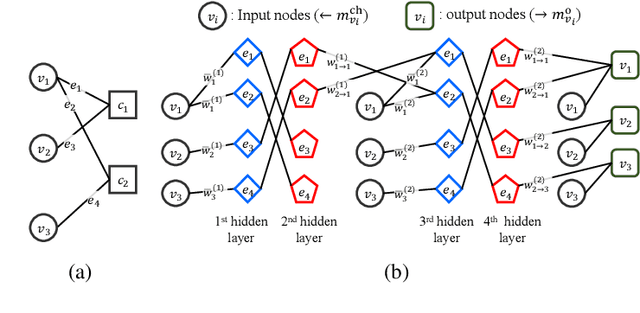


Abstract:Low-density parity-check (LDPC) codes have been successfully commercialized in communication systems due to their strong error correction ability and simple decoding process. However, the error-floor phenomenon of LDPC codes, in which the error rate stops decreasing rapidly at a certain level, poses challenges in achieving extremely low error rates and the application of LDPC codes in scenarios demanding ultra high reliability. In this work, we propose training methods to optimize neural min-sum (NMS) decoders that are robust to the error-floor. Firstly, by leveraging the boosting learning technique of ensemble networks, we divide the decoding network into two networks and train the post network to be specialized for uncorrected codewords that failed in the first network. Secondly, to address the vanishing gradient issue in training, we introduce a block-wise training schedule that locally trains a block of weights while retraining the preceding block. Lastly, we show that assigning different weights to unsatisfied check nodes effectively lowers the error-floor with a minimal number of weights. By applying these training methods to standard LDPC codes, we achieve the best error-floor performance compared to other decoding methods. The proposed NMS decoder, optimized solely through novel training methods without additional modules, can be implemented into current LDPC decoders without incurring extra hardware costs. The source code is available at https://github.com/ghy1228/LDPC_Error_Floor.
How to Mask in Error Correction Code Transformer: Systematic and Double Masking
Aug 25, 2023Abstract:In communication and storage systems, error correction codes (ECCs) are pivotal in ensuring data reliability. As deep learning's applicability has broadened across diverse domains, there is a growing research focus on neural network-based decoders that outperform traditional decoding algorithms. Among these neural decoders, Error Correction Code Transformer (ECCT) has achieved the state-of-the-art performance, outperforming other methods by large margins. To further enhance the performance of ECCT, we propose two novel methods. First, leveraging the systematic encoding technique of ECCs, we introduce a new masking matrix for ECCT, aiming to improve the performance and reduce the computational complexity. Second, we propose a novel transformer architecture of ECCT called a double-masked ECCT. This architecture employs two different mask matrices in a parallel manner to learn more diverse features of the relationship between codeword bits in the masked self-attention blocks. Extensive simulation results show that the proposed double-masked ECCT outperforms the conventional ECCT, achieving the state-of-the-art decoding performance with significant margins.
ISI-Mitigating Character Encoding for Molecular communications via Diffusion
Jun 05, 2023Abstract:This letter introduces a novel algorithm for generating codebooks in molecular communications (MC). The proposed algorithm utilizes character entropy to effectively mitigate inter-symbol interference (ISI) during MC via diffusion. Based on Huffman coding, the algorithm ensures that consecutive bit-1s are avoided in the resulting codebook. Additionally, the error-correction process at the receiver effectively eliminates ISI in the time slot immediately following a bit-1. We conduct an ISI analysis, which confirms that the proposed algorithm significantly reduces decoding errors. Through numerical analysis, we demonstrate that the proposed codebook exhibits superior performance in terms of character error rate compared to existing codebooks. Furthermore, we validate the performance of the algorithm through experimentation on a real-time testbed.
Weakly Private Information Retrieval Under Rényi Divergence
May 17, 2021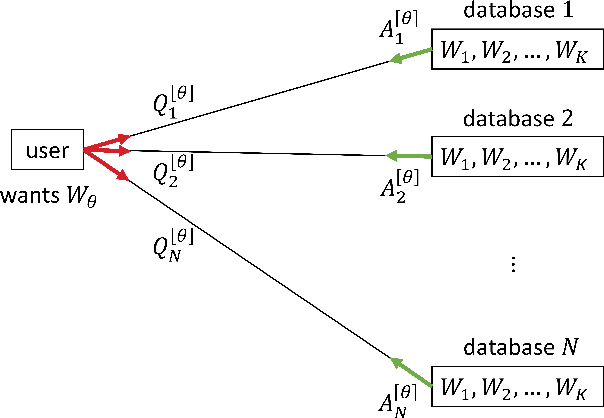
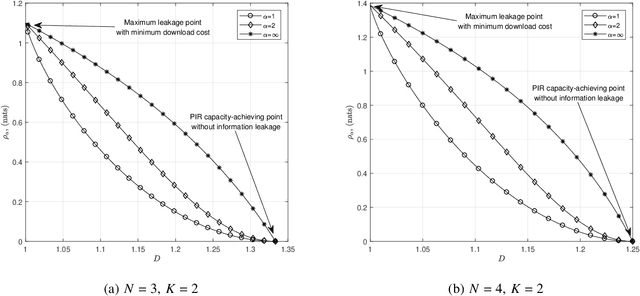
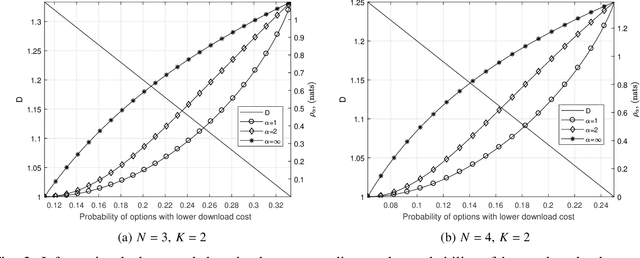
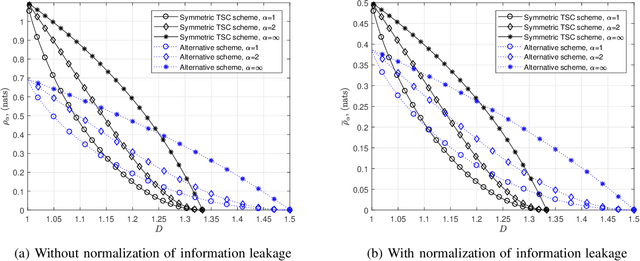
Abstract:Private information retrieval (PIR) is a protocol that guarantees the privacy of a user who is in communication with databases. The user wants to download one of the messages stored in the databases while hiding the identity of the desired message. Recently, the benefits that can be obtained by weakening the privacy requirement have been studied, but the definition of weak privacy needs to be elaborated upon. In this paper, we attempt to quantify the weak privacy (i.e., information leakage) in PIR problems by using the R\'enyi divergence that generalizes the Kullback-Leibler divergence. By introducing R\'enyi divergence into the existing PIR problem, the tradeoff relationship between privacy (information leakage) and PIR performance (download cost) is characterized via convex optimization. Furthermore, we propose an alternative PIR scheme with smaller message sizes than the Tian-Sun-Chen (TSC) scheme. The proposed scheme cannot achieve the PIR capacity of perfect privacy since the message size of the TSC scheme is the minimum to achieve the PIR capacity. However, we show that the proposed scheme can be better than the TSC scheme in the weakly PIR setting, especially under a low download cost regime.
 Add to Chrome
Add to Chrome Add to Firefox
Add to Firefox Add to Edge
Add to Edge